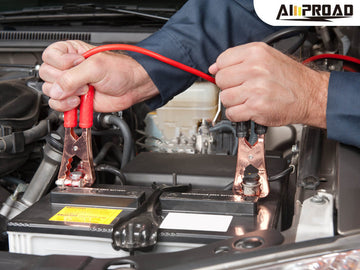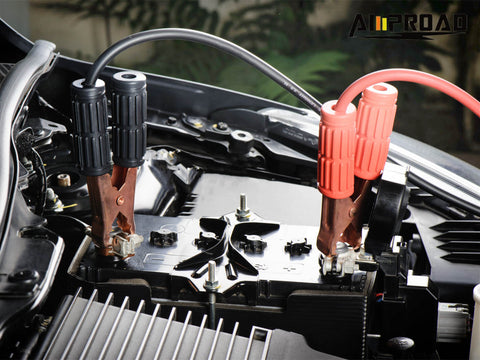Is It Okay to Use a Jump Starter with a Higher CCA Rating than My Car Needs?
May 13, 2024

Are you considering using a jump starter with a higher CCA rating for your car? Understanding the implications is crucial. Jump starters are essential tools for reviving a dead battery, but using one with a higher Cold Cranking Amps (CCA) rating than your vehicle requires might seem advantageous. However, it raises questions about potential risks and compatibility issues. In this article, we'll delve into the considerations surrounding this dilemma. From deciphering CCA ratings to exploring the impact on your vehicle, we'll equip you with the knowledge to make an informed decision. Let's navigate the intricacies of jump starters and ensure your vehicle stays safe on the road.
What is the purpose of a jump starter in a vehicle?
The purpose of a jump starter in a vehicle is crucial, especially in emergency situations when your car's battery dies. Essentially, a jump starter acts as a portable power source, providing the necessary boost to kick-start your vehicle's engine. But do you know how to boost a car easily?
Firstly, ensure both vehicles are turned off and the jump starter is fully charged. Then, connect the positive (+) cable of the jump starter to the positive terminal of the dead battery and the negative (-) cable to a grounded metal surface away from the battery. Next, connect the other end of the positive cable to the positive terminal of the working battery and the negative cable to the negative terminal of the working battery. Once connected, start the working vehicle and let it run for a few minutes. Afterward, attempt to start the vehicle with the dead battery. If successful, disconnect the cables in the reverse order of how they were connected. Remember to consult your vehicle's manual for specific instructions.
In essence, jump starters are lifesavers when your car won't start due to a dead battery. By following these easy steps, you can quickly and safely boost your car back to life, getting you back on the road in no time.
How does the CCA (Cold Cranking Amps) rating affect jump starter performance?

Understanding the Cold Cranking Amps (CCA) rating is essential for assessing jump starter performance. CCA measures a battery's ability to start an engine in cold temperatures. So, how does this rating impact jump starters?
A higher CCA rating indicates greater power output, meaning the battery booster can deliver more current to start a vehicle with a dead battery, especially in cold weather when batteries struggle the most. Conversely, a lower CCA rating may not provide sufficient power to start the engine, particularly in harsh conditions.
When selecting a jump starter, matching the CCA rating to your vehicle's requirements is crucial for effective performance. Using a jump starter with a CCA rating lower than what your car needs might not deliver enough power to start the engine, resulting in unsuccessful jump-start attempts.
On the other hand, using a jump starter with a higher CCA rating than required won't harm your vehicle. In fact, it can provide additional assurance, ensuring a more robust power supply for starting the engine, particularly in extreme weather conditions.
Understanding CCA Ratings
What does the CCA rating indicate about a jump starter's power output?
The CCA rating of a jump starter provides a measure of its power output capability, specifically in cold weather conditions. Essentially, it indicates how much current the jump starter can deliver to the vehicle's battery to initiate the engine start-up process. A higher CCA rating signifies a more robust power output, which is crucial for effectively jump start vehicles, particularly in colder climates where batteries tend to struggle.
How does the CCA requirement vary among different vehicles?
The CCA requirement varies among different vehicles based on factors such as engine size, age of the vehicle, and the climate in which it operates. Generally, larger engines and older vehicles require higher CCA ratings to start successfully, as they demand more power to overcome resistance in cold conditions. Additionally, vehicles operating in colder climates typically necessitate higher CCA ratings to compensate for the increased strain on the battery caused by lower temperatures.
It's essential to consult your vehicle's manual or specifications to determine the recommended CCA requirement. This ensures that you select a jump starter with a suitable CCA rating capable of effectively jump-starting your vehicle when needed. Failure to meet the CCA requirement could result in unsuccessful jump-start attempts, especially in adverse weather conditions. Therefore, understanding the variation in CCA requirements among different vehicles is crucial for choosing the right jump starter and ensuring reliable performance when it matters most.
Using a Jump Starter with Higher CCA

When considering using a jump starter with a higher CCA rating for your vehicle, it's natural to wonder about potential implications. Let's explore whether this decision could have any impact on your vehicle's well-being.
Can using a jump starter with a higher CCA rating harm my vehicle?
Using a jump starter with a higher CCA rating typically does not harm your vehicle. In fact, it can offer several benefits. Jump starters with higher CCA ratings provide a stronger initial burst of power, which can be advantageous for starting vehicles with larger engines or in extremely cold temperatures. However, it's essential to ensure that the jump starter is compatible with your vehicle's electrical system to avoid any potential issues.
What are the potential risks or benefits of using a higher CCA jump starter?
The primary benefit of using a higher CCA jump starter is increased reliability in starting your vehicle, especially in challenging conditions. Additionally, a higher CCA rating provides a safety margin, ensuring that the jump starter can handle unexpected variations in battery condition or temperature. However, there are minimal risks associated with using a higher CCA jump starter. In rare cases, if the jump starter delivers excessive current, it could potentially damage the vehicle's electrical system. Therefore, it's crucial to use the jump starter according to the manufacturer's guidelines and ensure compatibility with your vehicle.
Overall, using a jump starter with a higher CCA rating can offer peace of mind and improved performance when jump-starting your vehicle. Just be sure to verify compatibility and follow proper usage instructions to mitigate any potential risks.
Considerations for Compatibility
When choosing a vehicle booster pack, ensuring compatibility with your vehicle is essential for safe and effective use. Here are some factors to consider:
How can I determine the appropriate CCA rating for my vehicle?
Determining the appropriate CCA rating for your vehicle involves considering factors such as engine size, climate, and battery specifications. Consult your vehicle's manual or manufacturer specifications to find the recommended CCA rating. Additionally, you can use online resources or seek guidance from automotive professionals to ensure accuracy.
Are there any other factors besides CCA rating to consider when using a jump starter?
Yes, several other factors should be considered besides CCA rating:
- Voltage: Ensure that the jump starter matches your vehicle's voltage requirements, typically 12 volts for most cars and light trucks.
- Size and Portability: Choose a jump starter that is compact and easy to store in your vehicle for convenience during emergencies.
- Safety Features: Look for features such as reverse polarity protection and overload protection to prevent damage to your vehicle's electrical system.
- Additional Features: Some jump starters come with built-in flashlights, USB ports for charging devices, and air compressors, providing added functionality.
- Warranty and Customer Support: Consider the warranty and customer support offered by the manufacturer to ensure peace of mind and assistance in case of any issues.
- Weather Considerations: In extreme weather conditions, such as cold weather, opting for a slightly higher CCA-rated jump starter like that provided by AMPROAD can be beneficial. This can provide a more reliable start for your vehicle, boosting it in seconds. It offers a more convenient solution than jump cables when hearing the dreaded clicking noise, especially in bad weather.
By considering these factors in addition to CCA rating, you can select a jump starter that is not only compatible with your vehicle but also meets your specific needs and preferences.
Is it generally safe to use a jump starter with a higher CCA rating than my car needs?

Using a jump starter with a higher CCA rating than your car needs is generally safe and can even offer benefits. A higher CCA rating means the jump starter can deliver more power, which can be advantageous for starting vehicles with larger engines or in colder climates. It provides a stronger initial burst of power, ensuring a reliable start, especially in challenging conditions. However, it's important to ensure that the booster batterie is compatible with your vehicle's electrical system to avoid any potential issues. While using a higher CCA-rated jump starter poses minimal risks, it's crucial to follow proper usage instructions and consider factors like voltage and safety features. Ultimately, choosing a jump starter with a slightly higher CCA rating can provide added assurance and reliability when jump-starting your vehicle.
What precautions should be taken when using any jump starter with a vehicle?
When using any jump starter with a vehicle, several precautions should be taken to ensure safety and effectiveness. Firstly, carefully read and follow the manufacturer's instructions provided with the jump starter. Before connecting the jump starter to the vehicle's battery, ensure both vehicles are turned off to prevent electrical hazards. Additionally, check for any visible damage or defects on the jump starter cables and connectors before use.
When connecting the jump starter to the vehicle's battery, always attach the positive (+) cable to the positive terminal and the negative (-) cable to a grounded metal surface away from the battery to prevent sparks. Avoid touching the metal ends of the cables together or allowing them to come into contact with each other during use.
After successfully jump-starting the vehicle, disconnect the jump starter cables in the reverse order of how they were connected. Store the jump starter in a cool, dry place and recharge it as needed to maintain its performance for future use.
By following these precautions, you can safely and effectively use a jump starter to revive a dead battery and get your vehicle back on the road.


